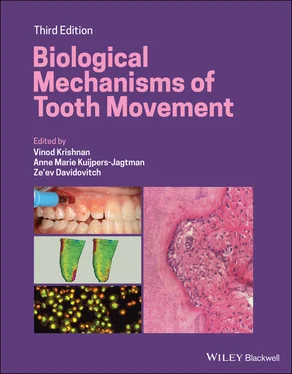In vivo studies demonstrated that MMP‐1, 2, 3, 8, 9, and 13 were expressed in the PDL and alveolar bone during OTM (Takahashi et al ., 2003, 2006; Garlet et al ., 2007; Leonardi et al ., 2007). Further, in vitro studies also demonstrated that the expression of MMP‐1 and MMP‐2 mRNA in human PDL cells was detected after exposure to mechanical stress (He et al ., 2004; Redlich et al ., 2004). When MMPs and TIMPs were investigated simultaneously in PDL under orthodontic forces, higher MMP‐1 levels were found in the compression than in the tension side, while TIMP‐1 levels were upregulated in the tension area (Garlet et al ., 2007), suggesting that there exists a differential pattern of expression providing distinct microenvironments favorable for extracellular matrix synthesis or degradation. The role of the MMP system in the regulation of OTM was experimentally confirmed, since the inhibition of MMPs activity with chemically modified tetracyclines, or by anti‐inflammatory or immunosuppressive drugs (such as potassium diclofenac and dexamethasone), inhibited experimental tooth movement in rats (Bildt et al ., 2007; Molina Da Silva et al ., 2017).
According to Lundy and Linden (2004) it is generally accepted that the nervous system contributes to the pathophysiology of peripheral inflammation, and a neurogenic component has been implicated in many inflammatory diseases including periodontitis. Neurogenic inflammation should be regarded as a protective mechanism, which forms the first line of defense and protects tissue integrity. Sensory neuropeptides play important roles in neurogenic inflammation, including vasodilatation, plasma extravasation, and recruitment of immune cells. However, a more extensive function for neuropeptides in the regulation of immune cell activity has also been proposed. During inflammation, there is a sprouting of peptidergic peripheral fibers and increased neuropeptide content.
Substance P and neurokinin A
SP and neurokinin A (NKA) are members of the tachykinin (tachy‐swift) neuropeptide family, and as such evoke rapid responses upon release. They exert a wide variety of biological actions and are intimately linked with neurogenic inflammation. The intensity of neurogenic inflammation has been shown to have a dose‐dependent relationship with the levels of SP and/or NKA. SP causes vasodilatation by acting directly on smooth‐muscle cells and indirectly by stimulating histamine release from mast cells in a concentration‐dependent manner. Increased microvascular permeability, edema formation, and subsequent plasma protein extravasation are prominent peripheral effects of the tachykinins, underlying their powerful proinflammatory properties. The SP‐induced contraction of endothelial cells and subsequent plasma extravasation allow substances such as bradykinin and histamine to gain access to the site of injury and to afferent nerve terminals. SP also interacts with other neurotransmitters: indeed, the characteristic edema formation mediated by SP has been shown to be modulated by nitrous oxide (Hughes et al ., 1990). Lee et al . (2007), who outlined the mechanism of action of SP on OTM, demonstrated increased expression of the chemokine C–C ligand (CCL) 20 mRNA, CCL20 protein, and heme oxygenase (HO)‐1 in a dose‐ and time‐dependent manner. SP is also responsible for initiating phosphorylation of IkappaB, degradation of IkappaB, and activation of nuclear factor (NF)‐kappaB. This reaction confirms the role of SP, along with other immunoregulators, in inducing HO‐1, and the inflammatory mediator macrophage inflammatory protein (MIP)‐3 alpha/CCL20 in PDL cells in the development of inflammation associated with OTM.
Calcitonin gene‐related peptide
CGRP is widely distributed throughout the central and peripheral nervous systems and is found at particularly high levels in sensory nerves. CGRP has potent vasodilator activity and is frequently co‐localized with SP. Bone tissue contains CGRP‐immunoreactive nerve fibers, whose increased concentrations during bone development and regeneration suggest that they are directly involved in the local regulation of bone remodeling. Further evidence shows that CGRP, which is derived from alternative splicing of calcitonin gene mRNA, plays a role in bone metabolism. It inhibits osteoclastic bone resorption by directly blocking osteoclast activation, or by indirectly regulating the osteoblast release of cytokines such as interleukin‐1 and TNF‐α, which can affect osteoclast function.
Villa et al . (2006) reported that CGRP influences the process of mechanically induced bone remodeling through its pro‐osteoclastogenic effect on the OPG/RANK/RANKL triad. Through this mechanism, it reduces OPG release and expression by hOB (human osteoblast‐like cells). Their results also demonstrated that the cAMP/PKA pathway is involved in the CGRP inhibition of OPG mRNA and protein secretion by hOB, and that this effect favors osteoclastogenesis. CGRP could thus modulate the balance between osteoblast and osteoclast activity, participating in the fine‐tuning of all of the bone remodeling phases necessary for the subsequent anabolic effect.
Vasoactive intestinal polypeptide
VIP is another neuropeptide with immunosuppressive properties. VIP is one of a group of regulatory molecules termed macrophage‐deactivating factors that are believed to prevent the excessive production of proinflammatory cytokines. Since the mid‐1990s, VIP has been identified as an important immunomodulatory peptide, capable of regulating the production of both pro‐ and anti‐inflammatory mediators. Interestingly, VIP can also counteract the inflammatory effects of DAMPs, suggesting that neural–immunological regulatory pathways can operate in the regulation of force‐induced OTM (Chorny and Delgado, 2008).
Neuropeptide Y (NPY) is a potent vasoconstrictor and amplifies the postsynaptic effects of other vasoconstrictors such as noradrenaline. The vasoconstrictor activities of NPY in vivo are mediated principally by the NPY Y1 receptor. In addition, NPY has potent angiogenic properties.
Neuropeptides and OTM: A synthesis
Norevall et al . (1995) observed that the expression of CGRP and SP increases in the PDL in response to buccally directed OTM of the upper first molar in the rat. Further, their continuous observations suggest that VIP and NPY, in contrast to the main sensory neuropeptides, CGRP and SP, are not involved in the tissue processes that occur in the remodeling of PDL and alveolar bone during OTM. In relation to tooth movement, Kvinnsland and Kvinnsland (1990) localized CGRP in the pulp and PDL of rats receiving orthodontic forces to maxillary molars for five days. In unstressed teeth, CGRP immunoreactivity was localized primarily in pulp and PDL nerves surrounding blood vessels. In moving teeth, the number of CGRP‐containing nerves in both pulp and PDL increased, and their staining intensified, particularly in PDL tension sites. In these areas, dark “spots,” which were probably fibroblasts that have bound CGRP released from stressed sensory nerve endings, were observed ( Figure 4.4). The experimental tooth movement induces dynamic changes in density and distribution of periodontal as well as pulpal nerve fibers, indicating their involvement in both early stages of PDL remodeling and, later, in its regenerative processes, generally occurring in concert with modulation of blood vessels (Vandevska‐Radunovic et al ., 1997). The study by Kato et al . (1996) suggested that the neurofilament protein (NFP)‐, CGRP‐, VIP‐ and NPY‐containing nerve fibers in the PDL play important roles in the modulation of pain, tissue remodeling, and blood flow regulation during tooth movement.
Читать дальше












